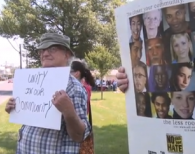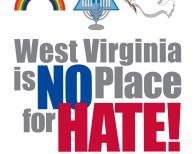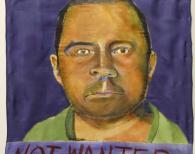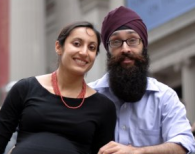community response

Gettysburg, PA, site of the famous battle that many consider a turning point in the Civil War, is commemorated annually with festivals, military re-enactments and celebrations of the town's rich history. This month marks the 150th anniversary of the historic battle.
Although America has become more inclusive, hate still sometimes rears its ugly head. In June 2010 the Aryan Nations came to Gettysburg to hold a rally on the historic battlefield where Abraham Lincoln delivered his most stirring defense of American democracy. The Adams Unity Coalition—a group made up of several local organizations—came together to hold their own peaceful rally across town that celebrated and embraced the diversity in their community. Check out this modern story of safety and inclusion in this video featuring the Adams Unity Coalition:

Photo: Katie Sokoler/Gothamist
Lights have been rising throughout the community of Oak Creek and beyond in commemoration and honor of the fallen - six individuals shot last Sunday at the Sikh Temple of Wisconsin.
Since the tragic killings, mourners of diverse backgrounds and religions have united in a number of candlelight vigils, from the immediate Sunday and then Tuesday night vigils in Oak Creek, to the vigils across the nation, of which more than 100 took place this week alone. A memorial service was held Friday morning for the six victims.
Friday's service took place at Oak Creek High School and drew hundreds of attendees wearing scarves over their heads in honor of Sikh tradition. Six coffins adorned with flowers stood in the gym, next to large, framed portraits of the deceased. A video projection commemorated the dead and wounded.

Today we uploaded three new files to the Not In Our Town Action Kit: Materials from West Virginia's successful multi-pronged action campaign titled, West Virginia: No Place for Hate.
Though this counter-protest occured in 2010, we believe these resources remain relevant and inspiring today. West Virginia leaders came together after Fred Phelps' Westboro hate group announced it would picket Catholic and Jewish institutions in the two towns, a local university, and a mine where more than a dozen miners had recently lost their lives.
The Not In Our Town Action Kit is a hidden gem on NIOT.org, compiling resources from communities standing up to hate and intolerance. In addition to these materials from West Virginia, you will find:

Here you will find materials used by other communities to stand up to hate in their town. You may download these materials and use them as inspiration in your own communities.
Charleston and Wheeling, West Virginia
In 2010, Fred Phelps' Westboro hate group announced it would picket Catholic and Jewish institutions in the two towns, a local university, and a mine where more than a dozen miners had recently lost their lives. The community launched "West Virginia: No Place for Hate," a multi-pronged action campaign that was featured on NIOT.org.
The statement below was published as a full-page ad in two Charleston newspapers in the spring of 2010. The heart image appeared alongside the statement as a tear-out poster, which community members were encouraged to display on their windows that week, as a response to messages of hate and representation of the "power of love in [the] community." Meanwhile, the West Virginia "No Place for Hate" poster was designed, printed and distributed by the WV Chamber of Commerce.

D.C. Chief of Police Cathy Lanier discusses the formation of the new task force during
an interview with the Washington Blade. Photo: Strother Gaines/Washington Blade
Washington, D.C. leaders are ramping up efforts to improve hate crime investigations.
Last month, the district mayor and police chief launched a task force that will evaluate how the Metropolitan Police Department investigates and reports hate crimes, particularly those targeting the LGBT community. The task force aims to identify and strengthen investigation weaknesses and build better police-community relations.

Human Relations Commission Vice-Chair Craig Blomberg speaks at the June 28 HRC meeting. Photo: Fred Gladdis/Davis Enterprise
The college town of Davis, Calif. won't let three recent hate incidents divide them. Instead, they are using the opportunity to unite.
The community is directing its energy creatively, literally coming together to produce a video collage titled "Speak Out for Tolerance" in response to the recent city hate incidents.

This is the first in a five-part series published by our public media partneras at Fronteras. Listen to the accompanying radio piece.
By Jude Joffe-Block
PHOENIX — Gilbert, Ariz. is a bedroom community outside of Phoenix that has seen explosive population growth in recent decades. As it grew from a small, conservative farming town into a more diverse community, some notable tensions arose.
“In 1993, our detectives started to identify in the town of Gilbert a gang that called themselves White Power,” said police spokesman Sergeant Bill Balafas.
Six years later, a spin-off gang called the Devil Dogs emerged among football players at Highland High School.
“Their belief system, we learned, was for white people and anti everything else,” Balafas said. “So they were racists, but that didn't mean they didn't beat up white people, they just beat up everybody.”

“As I watched this documentary unfold I found myself riveted to the screen. It deals with social issues that I hold dear, specifically how central a community can be for making changes. It restored a feeling of optimism in me to see how a community coming together can turn a frightful act into a hopeful new beginning.” — Berenice Pliskin, Artist After viewing Farmingville, a 2004 PBS documentary about the hate-based attempted murders of two Mexican day laborers on Long Island, New York artist Berenice Pliskin felt moved to depict the town’s conflict as a vibrant painting.

It is said that there is power in numbers, but when an increasing number of injustices were committed in Hayden Lake, Idaho, it was a small group of concerned citizens that stunted the growth of an American Nazi movement.
Three decades later, the story of the campaign for human rights that brought down the Aryan Nations--a once powerful organizing force that incorporated a white supremacist ideology with a frightening mix of anti-Semitism, racism, and Christianity--is now told in a one-hour documentary, The Color of Conscience. (To watch the full-length documentary, click here.)
Director Jay Krajic (left) and producer Marcia Franklin pose with two of the
founding members of the Kootenai County Task Force on Human relations,
